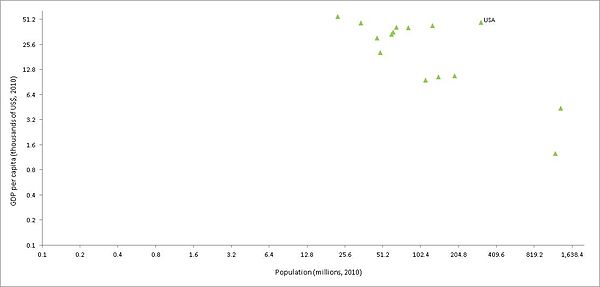The Trillion dollar club is an unofficial classification of the world's major economies with a gross domestic product (nominal GDP) of more than US$1 trillion per year.[1][2] As of 2017, it included 16 countries. This does not include purchasing power parity, which increases the GDP of many poorer countries.
Due to the world financial crisis, South Korea and Australia exited the trillion dollar club as their nominal GDPs shrank below $1 trillion in 2008 and 2009 respectively. Australia rejoined the list in 2010 while South Korea did so in 2011 as these countries' nominal GDPs once again were above $1 trillion. Accordingly, with the IMF, Mexico's estimated nominal GDP in 2009 also diminished below the trillion dollar mark, although other sources such as the CIA reported it above the mark.
Chronological order of current nations having at least US$500 billion economy
Former nations that had a US$500 billion economy
Chronological order of current nations having at least US$1 trillion economy

Former nations that had US$1 trillion economy
All of the G8 and BRIC countries are currently $1 trillion economies in United States dollars. Since currency valuations can be subject to rapid change, a country could achieve the US$1 trillion nominal GDP mark one year and then produce less than that in total goods and services the following year(s). The 2010 data used here are compiled according to the International Monetary Fund (IMF) values. As for the former Soviet Union, the last statistics about its economy stated that it had an over US$2.5 trillion economy in the 1990 fiscal year, before its collapse. Also, the Soviet Union reached US$1 trillion in 1978.
Chronological order of current nations having at least US$2 trillion economy
Former nation that had US$2 trillion economy
Chronological order of current nations having at least US$3 trillion economy
Chronological order of current nations having at least US$4 trillion economy
Chronological order of current nations having at least US$5 trillion economy
Chronological order of current nations having at least US$6 trillion economy
Chronological order of current nations having at least US$7 trillion economy
Chronological order of current nations having at least US$8 trillion economy
Chronological order of current nations having at least US$9 trillion economy
Chronological order of current nations having at least US$10 trillion economy
Chronological order of current nations having at least US$11 trillion economy
Chronological order of current nations having at least US$12 trillion economy
Chronological order of current nations having at least US$13 trillion economy
Chronological order of current nations having at least US$14 trillion economy
Chronological order of current nations having at least US$15 trillion economy
Chronological order of current nations having at least US$16 trillion economy
Chronological order of current nations having at least US$17 trillion economy
Chronological order of current nations having at least US$18 trillion economy
Chronological order of current nations having at least US$19 trillion economy
Chronological order of current nations having at least US$20 trillion economy
| This article uses material from the Wikipedia article Metasyntactic variable, which is released under the Creative Commons Attribution-ShareAlike 3.0 Unported License. |